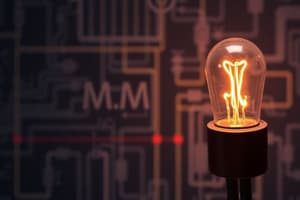Podcast
Questions and Answers
What are the components of a source-free R-C circuit?
What are the components of a source-free R-C circuit?
- Resistance (R) and Capacitance (C) (correct)
- Resistance (R) and Inductance (L)
- Resistance (R) and Current (C)
- Resistance (R) and Voltage (V)
What is the time constant in an RC circuit?
What is the time constant in an RC circuit?
- The product of resistance and capacitance (correct)
- The voltage across the capacitor
- The voltage across the resistor
- The ratio of inductance to resistance
Describe the behavior of an RC circuit for t > 0 after disconnecting a voltage source.
Describe the behavior of an RC circuit for t > 0 after disconnecting a voltage source.
- The resistance decreases
- The current increases exponentially
- The voltage decreases exponentially (correct)
- The voltage remains constant
What happens to the voltage across a capacitor in a source-free RC circuit over time?
What happens to the voltage across a capacitor in a source-free RC circuit over time?
How does the current behave in an RL circuit when the switch is opened?
How does the current behave in an RL circuit when the switch is opened?
What is the significance of the time constant in a first-order circuit?
What is the significance of the time constant in a first-order circuit?
Define the term 'transient response' in an electrical circuit.
Define the term 'transient response' in an electrical circuit.
What is meant by 'steady-state' in a circuit?
What is meant by 'steady-state' in a circuit?
What does the step response of a system include?
What does the step response of a system include?
What form of energy does a capacitor store in an RC circuit?
What form of energy does a capacitor store in an RC circuit?
How is energy stored in the inductor of an RL circuit dissipated?
How is energy stored in the inductor of an RL circuit dissipated?
Why is instantaneous voltage change across a capacitor not possible?
Why is instantaneous voltage change across a capacitor not possible?
What happens to the current in a source-free RL circuit after disconnecting the power source?
What happens to the current in a source-free RL circuit after disconnecting the power source?
According to Kirchhoff's voltage law, what should hold true for an RC circuit?
According to Kirchhoff's voltage law, what should hold true for an RC circuit?
In an RL circuit, what is the phase relationship between current and voltage?
In an RL circuit, what is the phase relationship between current and voltage?
Why are RC and RL circuits categorized as first-order circuits?
Why are RC and RL circuits categorized as first-order circuits?
Flashcards are hidden until you start studying
Study Notes
Components of Source-Free R-C Circuit
- Consists of Resistance (R) and Capacitance (C).
- No external sources powering the circuit, allowing analysis of natural behavior.
Time Constant in RC Circuit
- Defined as the product of resistance (R) and capacitance (C).
- Symbolized as τ (tau), indicating how quickly the circuit responds to changes.
Behavior of RC Circuit After Disconnecting Voltage Source
- Voltage across the capacitor decreases exponentially over time.
- Current flow diminishes as the stored charge dissipates.
Voltage Across Capacitor in Source-Free RC Circuit
- The voltage across the capacitor decreases exponentially.
- Reflects the capacitor discharging its stored energy over time.
Significance of Time Constant in First-Order Circuit
- The time constant signifies the time taken for the voltage or current response to decay by 63%.
- Impacts the speed of circuit response and energy storage dynamics.
Current Behavior in RL Circuit When Switch is Opened
- Current decreases exponentially after the switch is opened.
- Energy stored in the inductor is released gradually.
Voltage Across Inductor in RL Circuit
- As time approaches infinity, the voltage across the inductor decreases to zero.
- Reflects the energy dissipation and stabilization of the circuit.
Transient Response in Electrical Circuit
- Refers to the short-term response immediately following a disturbance or change.
- Characterizes how the system adapts before reaching steady-state conditions.
Steady-State in Circuit
- Represents the long-term behavior of the circuit after transient effects have dissipated.
- Circuit behavior stabilizes once all stored energy is balanced.
Natural Response vs. Step Response in RC Circuit
- Natural response depends only on initial conditions with no external sources affecting it.
- Step response is the circuit's reaction to a sudden change in voltage or current.
Role of Capacitor in Energy Storage of RC Circuit
- Stores energy in the form of electric charge.
- Provides the ability to release energy back into the circuit when required.
Energy Dissipation in RL Circuit
- Energy stored in the inductor dissipates as heat in the resistor over time.
- This process occurs as the magnetic field generated by the inductor collapses.
Voltage Change in Capacitor
- Voltage across a capacitor cannot change instantaneously because it requires time to charge or discharge.
- This property helps in smoothing out fluctuations in electrical signals.
Behavior of Source-Free RL Circuit After Disconnecting External Source
- Current decreases exponentially when the external source is disconnected.
- Indicates the inductor's energy is dissipated gradually instead of instantly.
Kirchhoff's Voltage Law in RC Circuits
- States that the sum of voltages around any closed loop in a circuit must equal zero.
- Ensures conservation of energy within the electrical circuit.
Current and Voltage Relationship in RL Circuit
- Current lags the voltage due to the inductor's reactive properties.
- The phase difference reflects how the inductor influences circuit dynamics.
First-Order Circuits: RC and RL
- Termed first-order circuits because their governing equations are first-order differential equations.
- This property simplifies analysis compared to higher-order circuits with multiple energy storage elements.
Studying That Suits You
Use AI to generate personalized quizzes and flashcards to suit your learning preferences.




